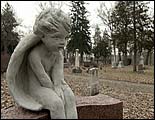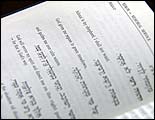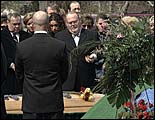BOB ABERNETHY, anchor: Many people know Rabbi Harold Kushner for his 1981 book WHEN BAD THINGS HAPPEN TO GOOD PEOPLE. Recently, Rabbi Kushner wrote a meditation on the 23rd Psalm called THE LORD IS MY SHEPHERD. Rabbi Kushner affirms that the 23rd Psalm answers the question, how do you live in a dangerous and unpredictable world?
Rabbi HAROLD KUSHNER: No matter how grievous a funeral was, no matter how tragic a memorial service was, if I just started to recite the familiar words of the twenty-third Psalm, “The Lord is my shepherd, I shall not want. He makes me to lie down in green pastures …” it tranquilized the congregation. It just made people feel calm.
 Right after 9/11 — when everybody was asking me, “Where was God that Tuesday? How could God have let such a thing happen?” — the answer I found myself giving was, “God’s promise was never that life would be fair. God’s promise was, when it’s your turn to confront the unfairness of life, no matter how hard it is, you’ll be able to handle it, because He’ll be on your side. He will give you the strength you need to find your way through.”
Right after 9/11 — when everybody was asking me, “Where was God that Tuesday? How could God have let such a thing happen?” — the answer I found myself giving was, “God’s promise was never that life would be fair. God’s promise was, when it’s your turn to confront the unfairness of life, no matter how hard it is, you’ll be able to handle it, because He’ll be on your side. He will give you the strength you need to find your way through.”
Cantor Deborah Togut (B’nai Israel, Rockville, MD): [Chants Psalm twenty-three in Hebrew.]
 KUSHNER: I was paraphrasing the twenty-third Psalm: “Though I walk through the valley of the shadow of death, I will fear no evil, for Thou art with me.” The psalmist is not saying, “I will fear no evil because evil only happens to people who deserve it.” He’s saying, “This is a scary, out-of-control world, but it doesn’t scare me, because I know that God is on my side, not on the side of the hijacker. God is on my side, not on the side of the illness, or the accident, or the terrible thing that happened. And that’s enough to give me the confidence.” The twenty-third Psalm is the answer to the question, “How do you live in a dangerous, unpredictable, frightening world?”
KUSHNER: I was paraphrasing the twenty-third Psalm: “Though I walk through the valley of the shadow of death, I will fear no evil, for Thou art with me.” The psalmist is not saying, “I will fear no evil because evil only happens to people who deserve it.” He’s saying, “This is a scary, out-of-control world, but it doesn’t scare me, because I know that God is on my side, not on the side of the hijacker. God is on my side, not on the side of the illness, or the accident, or the terrible thing that happened. And that’s enough to give me the confidence.” The twenty-third Psalm is the answer to the question, “How do you live in a dangerous, unpredictable, frightening world?”
I want to believe in a loving God. And when you see children dying, when you see innocent people suffering, and when you see young parents stricken with an illness, how can you believe in a God of love and compassion unless you are prepared to say, “Some things happen in the world that God does not want to happen.” God is good. Nature is not good. Nature is blind. Nature is amoral. Fire burns and bullets wound and falling rocks injure and disease germs infect everybody, whether you deserve it or not.
 I was inspired to write all of my books, starting with WHEN BAD THINGS HAPPEN TO GOOD PEOPLE, by the death of my son, who was 14 years old and was born with an incurable illness. I asked myself, how did my wife and I get through that? You would think that would shatter the faith of the average person. Where did we find the strength and the ability to raise him, to comfort him when he was sick and scared, and ultimately to lose him? And the only answer is, when we used up all of our own strength and love and faith, there really is a God, and he replenishes your love and your strength and your faith.
I was inspired to write all of my books, starting with WHEN BAD THINGS HAPPEN TO GOOD PEOPLE, by the death of my son, who was 14 years old and was born with an incurable illness. I asked myself, how did my wife and I get through that? You would think that would shatter the faith of the average person. Where did we find the strength and the ability to raise him, to comfort him when he was sick and scared, and ultimately to lose him? And the only answer is, when we used up all of our own strength and love and faith, there really is a God, and he replenishes your love and your strength and your faith.
But people who have been hurt by life get stuck in “the valley of the shadow,” and they don’t know how to find their way out. And that’s the role of God. The role of God is not to explain and not to justify but to comfort, to find people when they are living in darkness, take them by the hand, and show them how to find their way into the sunlight again.
 Why do people let themselves get stuck? Sometimes, I think, they feel guilty that they’re still alive and somebody they love has died. Sometimes, I suspect, they’re afraid. They’re afraid if they ever permitted themselves to recover, then they would lose the person not only physically but emotionally as well. And as a rabbi, I would try to explain to them, “No, that’s not how it works. When you have loved somebody, they have entered so intimately into the fabric of your soul that neither death nor time can ever take them out. They are always with you.”
Why do people let themselves get stuck? Sometimes, I think, they feel guilty that they’re still alive and somebody they love has died. Sometimes, I suspect, they’re afraid. They’re afraid if they ever permitted themselves to recover, then they would lose the person not only physically but emotionally as well. And as a rabbi, I would try to explain to them, “No, that’s not how it works. When you have loved somebody, they have entered so intimately into the fabric of your soul that neither death nor time can ever take them out. They are always with you.”
[Reading Psalm 23:] “Goodness and mercy shall follow me all the days of my life; and I shall dwell in the House of the Lord forever.”

 SEVERSON: Angel was one of them, until prison and now this effort at redemption. His real family was messed up and drugged out. His gang family took care of him, and he took care of them. Angel was no angel.
SEVERSON: Angel was one of them, until prison and now this effort at redemption. His real family was messed up and drugged out. His gang family took care of him, and he took care of them. Angel was no angel. Father GREG BOYLE: I buried my first kid in 1988. I buried my 128th yesterday. There is a lethal absence of hope in a community like this. You get more kids planning their funerals than their futures. And what you hope to do, especially in a program like this, is to help them conjure up an image of what tomorrow will look like, because if you can’t see your future, you aren’t going to find your present very compelling. And that is a dangerous place to be.
Father GREG BOYLE: I buried my first kid in 1988. I buried my 128th yesterday. There is a lethal absence of hope in a community like this. You get more kids planning their funerals than their futures. And what you hope to do, especially in a program like this, is to help them conjure up an image of what tomorrow will look like, because if you can’t see your future, you aren’t going to find your present very compelling. And that is a dangerous place to be. Father BOYLE: It is absolutely all religious. There is no kind of “Here’s the part that is spiritual, here’s the part that is God. Here is the part that speaks a spiritual message,” you know. It is far more important not to announce a message to the folks that come in here, but to become that message to the folks that come in here.
Father BOYLE: It is absolutely all religious. There is no kind of “Here’s the part that is spiritual, here’s the part that is God. Here is the part that speaks a spiritual message,” you know. It is far more important not to announce a message to the folks that come in here, but to become that message to the folks that come in here. SEVERSON: In what kind of situations?
SEVERSON: In what kind of situations? SEVERSON: It followed fellow homeboy Miguel Gomez, who was shot and killed in June removing graffiti.
SEVERSON: It followed fellow homeboy Miguel Gomez, who was shot and killed in June removing graffiti.
 One common tradition is to eat apples and honey for a sweet New Year. A pomegranate has been incorporated because a pomegranate has many seeds, and it is a symbol of fertility, so we should be a fertile people. We have a round challah symbolizing that that there is no beginning to our lives. The year might start at Rosh Hashanah, but really it’s cyclical.
One common tradition is to eat apples and honey for a sweet New Year. A pomegranate has been incorporated because a pomegranate has many seeds, and it is a symbol of fertility, so we should be a fertile people. We have a round challah symbolizing that that there is no beginning to our lives. The year might start at Rosh Hashanah, but really it’s cyclical.





 TOM WHITE (Industrialist): I’ve taken care of my wife and my children, so everybody’s okay. What’s the point in having any other money? You see something like 9/11 and you realize there are no guarantees. So, do it now. I have this sense of urgency: take care of things immediately because I could be dead the next day, or the people I want to help could be dead.
TOM WHITE (Industrialist): I’ve taken care of my wife and my children, so everybody’s okay. What’s the point in having any other money? You see something like 9/11 and you realize there are no guarantees. So, do it now. I have this sense of urgency: take care of things immediately because I could be dead the next day, or the people I want to help could be dead. Mr. WHITE: The only way in life to go through life is to look at things from the bottom up. You can never appreciate how bad things are for the truly poor and marginalized unless you do get down to that level and look around.
Mr. WHITE: The only way in life to go through life is to look at things from the bottom up. You can never appreciate how bad things are for the truly poor and marginalized unless you do get down to that level and look around. Dr. FARMER: We say at the end of the day we’ve made it through, we got the patients seen, and we saw a lot of patients, and diagnosed a lot of treatable disease. When you do that, treat it, you have the tools, you influence people’s lives on a daily basis — I think that’s very significant.
Dr. FARMER: We say at the end of the day we’ve made it through, we got the patients seen, and we saw a lot of patients, and diagnosed a lot of treatable disease. When you do that, treat it, you have the tools, you influence people’s lives on a daily basis — I think that’s very significant. VALENTE: That pretty much excludes his alma mater, Harvard University.
VALENTE: That pretty much excludes his alma mater, Harvard University. LAWTON: Over the centuries, the story of Jesus’ crucifixion and resurrection has been told, and retold, through art, music, and drama. And public interest hasn’t waned.
LAWTON: Over the centuries, the story of Jesus’ crucifixion and resurrection has been told, and retold, through art, music, and drama. And public interest hasn’t waned. LAWTON: In Gibson’s depiction, virtually the entire film focuses on the crucifixion and the violence leading up to it; only a few seconds at the end are devoted to the resurrection.
LAWTON: In Gibson’s depiction, virtually the entire film focuses on the crucifixion and the violence leading up to it; only a few seconds at the end are devoted to the resurrection. LAWTON: Other Christians may concentrate on the suffering of the crucifixion without remembering the rest of the story. But Fleming Rutledge says the resurrection vindicates the crucifixion.
LAWTON: Other Christians may concentrate on the suffering of the crucifixion without remembering the rest of the story. But Fleming Rutledge says the resurrection vindicates the crucifixion. MIROSLAV VOLF (Director, Center for Faith and Culture, Yale Divinity School): Once this occupation of my own country had taken place, I suddenly felt a surge of violence within me, and I was not sure exactly what I ought to do as a Christian. And that put on the map for me the question, how does one think as a Christian about situations of violence, and how does Christian faith interact in our violent world?
MIROSLAV VOLF (Director, Center for Faith and Culture, Yale Divinity School): Once this occupation of my own country had taken place, I suddenly felt a surge of violence within me, and I was not sure exactly what I ought to do as a Christian. And that put on the map for me the question, how does one think as a Christian about situations of violence, and how does Christian faith interact in our violent world? Dr. VOLF: We all try to teach our children, well, share that toy, right? There’s your turn, and there’s other person’s turn. “Well, look what Aaron wants now. Try to imagine yourself in his shoes. What would you do if you were in his place?”
Dr. VOLF: We all try to teach our children, well, share that toy, right? There’s your turn, and there’s other person’s turn. “Well, look what Aaron wants now. Try to imagine yourself in his shoes. What would you do if you were in his place?” ABERNETHY: As Volf studies religion and everyday life as director of the Yale Center for Faith and Culture, he emphasizes his belief that for Christians, pursuing justice is not enough. They must go further.
ABERNETHY: As Volf studies religion and everyday life as director of the Yale Center for Faith and Culture, he emphasizes his belief that for Christians, pursuing justice is not enough. They must go further. Dr. VOLF: I find it almost like an insult to human nature, an insult to religious people, whatever religion they belong to, to say, “We have to agree at the bottom in order to be able to live in peace.” I want to believe that if you and I disagree about something, that we can still be very good neighbors; indeed, that we can be friends. And that ought to apply also for our various world religions. We can disagree. We can disagree on profound matters of life and nevertheless, we can live in peace with one another. Why? Because I do believe that different religions have their own internal resources which will motivate us to live in peace, indeed, to love those who differ from us.
Dr. VOLF: I find it almost like an insult to human nature, an insult to religious people, whatever religion they belong to, to say, “We have to agree at the bottom in order to be able to live in peace.” I want to believe that if you and I disagree about something, that we can still be very good neighbors; indeed, that we can be friends. And that ought to apply also for our various world religions. We can disagree. We can disagree on profound matters of life and nevertheless, we can live in peace with one another. Why? Because I do believe that different religions have their own internal resources which will motivate us to live in peace, indeed, to love those who differ from us. In the Book of Exodus, it tells us that during Passover, during eight days, you should not use any leavened items and leavened bread. Today it would mean pizza, pasta, corn, beans, rice, even mustard seed — things that are leavened or fermented.
In the Book of Exodus, it tells us that during Passover, during eight days, you should not use any leavened items and leavened bread. Today it would mean pizza, pasta, corn, beans, rice, even mustard seed — things that are leavened or fermented. “Marorra,” which means bitter — and it was greens like Romaine lettuce or arugula — that’s what grows in the desert, not horseradish. Horseradish is Eastern European, and they all mean — again, they are symbols of the bitterness of slavery.
“Marorra,” which means bitter — and it was greens like Romaine lettuce or arugula — that’s what grows in the desert, not horseradish. Horseradish is Eastern European, and they all mean — again, they are symbols of the bitterness of slavery.